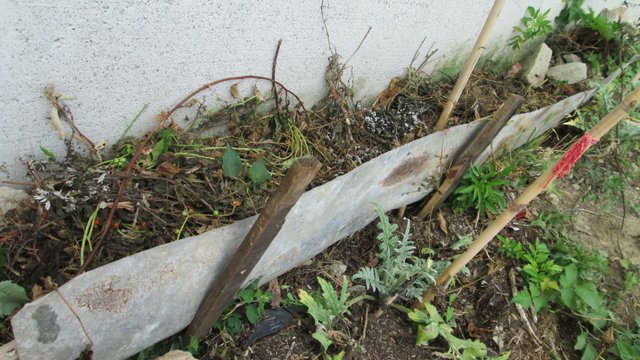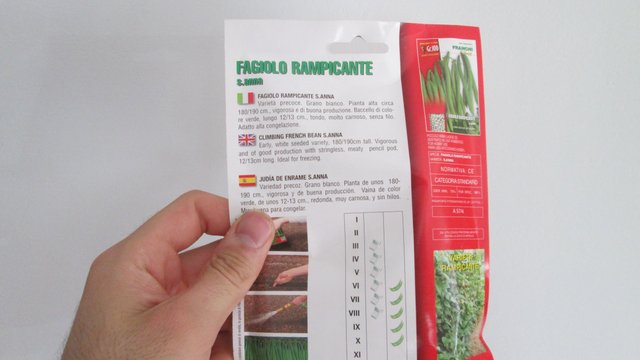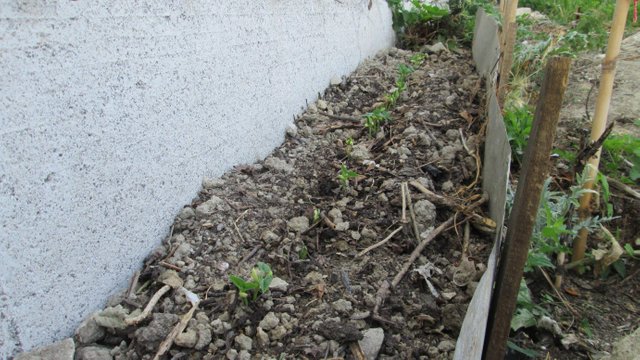In this post I'll show you how I built this morning a raised bed for growing beans, using resources that were available (almost zero-cost) and pursuing several goals at the same time.
In questo post vi mostrerò come ho costruito questa mattina un letto rialzato per piantare fagioli, utilizzando le risorse che avevo a disposizione (quasi a costo zero) e inseguendo contemporaneamente diversi obiettivi.
Ingredients - Ingredienti

- A wall
- Board
- Soil
- Grasses
- Chicken manure
- Fertilizer
- Un muro
- Una tavola
- Terra
- Sfalci d'erba
- Concime di galline
- Ammendante
Making of - Preparazione
To prepare the raised bed for climbing beans, I first chose a place near a wall. Why bother to create supports later, if beans can climb to a wall? To be precise: said wall offers many iron pieces where I can tie some strings to.
Second, I took a piece of sheet metal that was thrown into a corner and used it to hold the ground. When I can recycle I'm happy; you give new life to an object and in the meantime you order the space (and you dont' need to go throwning something in the bin).
I've created a bed of grass and sprigs. This choice was inspired by reading an article on Steemit (I couldn't manage to found it again) on Hügelkultur. This technique involves cultivating over a bunch of logs, mosses and soil. The organic material under the roots creates a sort of sponge that holds the water longer.
Then I added the manure of my hens.
I covered with soil I dug where I want to create a fountain to collect water.
I added the fertilizer (equine manure).
Per preparare il letto rialzato per fagioli rampicanti, ho innanzitutto scelto un posto vicino ad un muro. Perché darsi il lavoro di creare successivamente i sostegni, se i fagioli si possono arrampicare ad un muro? Per essere precisi: il muro in questione ha una serie di pezzetti di ferro che mi permetteranno di legare il cordino a cui si arrampicheranno i fagioli.
In secondo luogo, ho preso un pezzo di lamiera che stava buttato in un angolo e l'ho usato per contenere la terra. Quando posso utilizzare dei pezzi di recupero sono contento; così si dà nuova vita ad un oggetto e nel frattempo si fa ordine.
Ho creato un letto di sfalci d'erba e rametti. Questa scelta mi è stata ispirata dal leggere un articolo su Steemit (non l'ho più ritrovato) sulla Hügelkultur. Questa tecnica consiste nel coltivare sopra un cumulo di tronchi, sfalci e terriccio. Il materiale organico sotto le radici crea una sorta di spugna che trattiene a lungo l'acqua.
Ho poi aggiunto del concime delle mie galline.
Ho ricoperto con terra che ho scavato nel punto in cui voglio creare una fontana per raccogliere acqua.
Ho aggiunto dell'ammendante (letame equino).

One work, several goals - Un lavoro, molti obiettivi
With these simple actions, I managed to move in the direction of not just one, but several goals. It's not just about planting beans, it's about expanding the production capacity of my land, recovering a space that has never been used for cultivation.
I could also get rid of a piece of sheet metal that looked ugly in a corner and that I would otherwise have to throw away (there's really very little that we throw away). Using that metal, it looks now less messy all around: the same to be said about grass cut-offs. Where you once saw the drying grass, you now see the green lawn.
I could then use the soil I dig for the fountain; this way, I went on digging and at the same time I recovered a resource I needed. I used almost only the resources I had available. The only thing that was bought in the past was the equine manure.
Con questo semplice lavoro, sono riuscito a muovermi nella direzione di non solo uno, ma tanti obiettivi. Non si tratta solo di piantare fagioli, si tratta di espandere la capacità produttiva della mia terra, recuperando uno spazio che non era mai stato usato per la coltivazione.
Inoltre ho potuto liberarmi di un pezzo di lamiera che faceva disordine e che altrimenti avrei dovuto smaltire in qualche altra maniera. Così quell'angolo ora sembra più ordinato: stesso discorso per gli sfalci d'erba. Dove prima si vedevano gli sfalci, ora si vede il prato verde.
Ho poi potuto usare la terra che scavo per la fontana; in questo modo sono andato avanti nel lavoro di scavo e allo stesso tempo ho recuperato una risorsa che mi serviva.
In questo modo ho utilizzato quasi tutte risorse che avevo a disposizione. L'unica cosa che è stata comprata è stato il letame equino.

At the end of this day - Al termine di questa giornata
At the end of this day I am pleased to have taken some further steps towards our goals. Before dinner I went down to plant the climbing beans and I hope to be able soon to post in the comments to this post some photos of the plants. The greatest satisfaction for me stems from thinking "wide", holistic: doing a job and pursuing multiple goals at the same time. My goals are known by those who follow my publications: reduce the cost of living (and therefore be more free to have time), eat what I cultivate, make the best use of all the available resources. Being the change that we want in the world.
Al termine di questa giornata sono soddisfatto di essermi portato un po' avanti con i lavori che mi sono prefissato. Prima di cena sono sceso a piantare i fagioli rampicanti e spero presto di poter pubblicare nei commenti a questo post le foto delle piante. La soddisfazione maggiore per me nasce dal pensare "in grande": fare un lavoro e inseguire più obiettivi contemporaneamente. Obiettivi, questi ultimi, che sono conosciuti da chi segue le mie pubblicazioni: ridurre il costo della vita (e quindi essere più liberi di disporre del proprio tempo), mangiare ciò che si coltiva, utilizzare al meglio tutte le risorse che si hanno a disposizione. Essere il cambiamento che si vuole nel mondo.


Thankyou for the post on your techniques
im interested to see your results so im following
Ive found beans are medium to low demand but like the soil well broken down first.
The technique youive used is good to build up soil hoever if you have problems then perhaps try growing another crop usin this method first then try beans the following year
for example something thats is ok with the mix like this would be potatos
then after its broken down more, add dolomite lime the following year, then try beans
and the third season follow with Lettuce and onion family
Downvoting a post can decrease pending rewards and make it less visible. Common reasons:
Submit
Wow, thank you so much for these informations. I'm interested in see how this will results too, as it is an experiment. I'll publish pictures soon.
I'm now following you as I found so many valuable posts on your page: I'm currently very interested in plant propagation and compost toilets.
Downvoting a post can decrease pending rewards and make it less visible. Common reasons:
Submit
The beans have sprouted

Downvoting a post can decrease pending rewards and make it less visible. Common reasons:
Submit
Forte...!!
Downvoting a post can decrease pending rewards and make it less visible. Common reasons:
Submit
Quando i fagioli saranno maturi, facciamo una fagiolata stile Bud Spencer e Terence Hill!
Downvoting a post can decrease pending rewards and make it less visible. Common reasons:
Submit
😊
Downvoting a post can decrease pending rewards and make it less visible. Common reasons:
Submit
I didn't have chicken manure, but I substituted goat manure.
So, I have everything but the wall.
I went down to Wallmart to get one, but I found they had no walls for sale.
:-p
Downvoting a post can decrease pending rewards and make it less visible. Common reasons:
Submit
Do you have goats? We are looking forward to take some little goats next spring.
Yes, it's a pity...Wallmart does no longer sell the good walls it used to sell...hard times for climbing beans these...
I'm your 667th follower: you are out of the 666 spell now! :-p
Downvoting a post can decrease pending rewards and make it less visible. Common reasons:
Submit
Hurray! Thank you. I am saved.
I have a friend with goats, and so can get shit. Which is good.
Goats are nice, playful and small. They will try to get everywhere. Cows are so big and squash your fences.
Downvoting a post can decrease pending rewards and make it less visible. Common reasons:
Submit
:-)
Next year I'll have goats too, I can't wait.
Downvoting a post can decrease pending rewards and make it less visible. Common reasons:
Submit
I like raised bed gardening and container gardening. It is a bit more cost at first but easier upkeep I believe.
Downvoting a post can decrease pending rewards and make it less visible. Common reasons:
Submit
I think the same. I started gardening the old way, but now I'm gradually switching to raised beds as it looks more economical. To be successfull in growing plants directly on the ground you need machinery...and that's expensive.
Downvoting a post can decrease pending rewards and make it less visible. Common reasons:
Submit